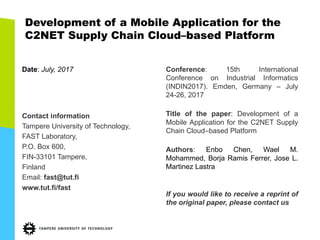Development of a Mobile Application for the C2NET Supply Chain CloudŌĆōbased Platform
- 1. Development of a Mobile Application for the C2NET Supply Chain CloudŌĆōbased Platform Date: July, 2017 Contact information Tampere University of Technology, FAST Laboratory, P.O. Box 600, FIN-33101 Tampere, Finland Email: fast@tut.fi www.tut.fi/fast Conference: 15th International Conference on Industrial Informatics (INDIN2017). Emden, Germany ŌĆō July 24-26, 2017 Title of the paper: Development of a Mobile Application for the C2NET Supply Chain CloudŌĆōbased Platform Authors: Enbo Chen, Wael M. Mohammed, Borja Ramis Ferrer, Jose L. Martinez Lastra If you would like to receive a reprint of the original paper, please contact us
- 2. Development of a Mobile Application for the C2NET Supply Chain CloudŌĆō based Platform IEEE 15th International Conference of Industrial Informatics (INDIN 2017), Emden, Germany Enbo Chen, Wael M. Mohammed, Borja Ramis Ferrer, Jose L. Martinez Lastra {enbo.chen, wael.mohammed, borja.ramisferrer, jose.lastra}@tut.fi Tampere University of Technology, 33720 Tampere, Finland
- 3. Outline ŌĆó Introduction ŌĆó Motivation ŌĆó Background ŌĆó The approach ŌĆó Outcomes ŌĆó Conclusion and the future work
- 4. Introduction Cloud Collaborative Manufacturing Networks (C2NET) project is an EU Horizon 2020 R&D project within the framework of the Factories of the Future (FoF) public- private partnership. The goal of the project is the development of Cloud-enabled tools for supporting SMEs supply network optimization.
- 5. Motivation ŌĆó As C2NET aims at providing a web-based collaborative platform, it is important to support the users with a connectivity and visualization using web browsers and mobile applications. ŌĆó The users of C2NET needs to be informed or notified about the updates that occur in the platform. ŌĆó The mobile should address the fact of C2NET development phase.
- 6. Background User Collaboration Network The term of collaborative networks addresses the interaction between persons as users and companies or organizations as networks. The interaction could cover different fields. As an example, Facebook social media, Research Gate and LinkedIn.
- 7. Background Platform as a Service and OpenPaaS Cloud computing has three stacks (from bottom to top): ŌĆó Infrastructure as a Service (IaaS) provides servers, networking, storage, and data center space and other hardware infrastructure. ŌĆó Platform-as-a-Service (PaaS) offers the cloud-based environment with everything required to support building and delivering web application. ŌĆó Software as a Service (SaaS) enabling software applications are to be used by others and that connect to usersŌĆÖ computers via the internet and, usually, a web browser. OpenPaaS is an open source collaboration platform developed by LINAGORA6, an open source software company, which is implemented with PaaS technology for enterprises and organizations. http://open-paas.org/
- 8. Approach ŌĆó Since it is a web based application, two sides are introduced in the architecture; server and client ŌĆó The UCP is based on the OpenPaaS platform ŌĆó The Mobile application is developed for Android OS
- 9. Approach UCP Side (Server) ŌĆó Webserver, Authenticator, Database, PubSub and Web Socket server are provided by OpePaaS ŌĆó Controller: manages the connected Mobile applications ŌĆó User Model manages the stored users with relation to notifications and devices ŌĆó Web Socket logic handles the communication protocols.
- 10. Approach UCP Side (Server) ŌĆó Webserver, Authenticator, Database, PubSub and Web Socket server are provided by OpePaaS ŌĆó Controller: manages the connected Mobile applications ŌĆó User Model manages the stored users with relation to notifications and devices ŌĆó Web Socket logic handles the communication protocols.
- 11. Approach Mobile Application Side (Client) ŌĆó Init : for testing the connection and request the cookies and tokens (if the user already authorized). ŌĆó Login: allows the user to authinticate him/herself. Needed just once. ŌĆó Home: web browser. ŌĆó Notification service: background service for web socket connection. ŌĆó Notifications: shows the list of the notifications
- 12. Outcomes UCP View on the web browser
- 13. Outcomes UCP View on the web browser
- 14. Outcomes UCP View on the web browser
- 15. Outcomes Mobile application screens examples
- 16. Outcomes Mobile application screens examples
- 17. Conclusion ŌĆó The mobile application development increased the flexibility and the expandability of the GUI of the C2NET platform ŌĆó The development is focused on one side which reduced the effort.
- 18. Future Work ŌĆó Expand the deployment of the application to cover more operating systems. ŌĆó Reduce the ad hoc implementation as much as possible.
- 19. Acknowledgement The research leading to these results has received funding from the European UnionŌĆÖs Horizon 2020 research and innovation program under grant agreement n┬░636909, correspondent to the project shortly entitled C2NET, Cloud Collaborative Manufacturing Networks .




















